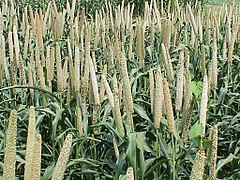雜谷
雜穀(英語:millet)是農學分類,指的是各種具有小粒種子的穀類作物,在全世界廣泛種植作為糧食與飼料。雜穀並不是生物學分類概念,沒有對應的分支群。[1] 雜穀在世界各地都有獨立馴化。[2] 東亞最早馴化的雜谷為黍,已種植約一萬年。[3]

雜谷在高溫、缺水的環境下仍能維持較高的農業生產力,且種植季節短。雜谷在半乾旱熱帶地區,如南印度、馬里、尼日利亞、尼日爾特別重要。全球97%的雜谷是由發展中國家產出。[4]
「雜谷」一詞有時包含高粱屬作物;高粱的年產量為其他雜谷總和的兩倍。[5]去除高粱,每年產量最高的是原產非洲的御穀,接下來是穇子、黍、小米。[6]
2023年是聯合國糧農組織定下的國際雜谷年(官方譯為「國際小米年」,但涉及的物種不只為小米Setaria italica一種)[7]。[8]
雜穀物種
編輯雜穀屬於禾本科。
- 黍亞科 (Panicoideae)
- 御穀(Pennisetum glaucum)
- 小米(Setaria italica)
- 高粱
- 黍(Panicum miliaceum) 即糜子
- 紫穗稗(Echinochloa esculenta)
- 鴨乸草(Paspalum scrobiculatum)
- 細柄黍(Panicum sumatrense)
- 彎臂粟 ('Urochloa deflexa) 英文名:Guinea millet
- 多枝臂形草(Brachiaria ramosa)
- 直長馬唐 英語:Fonio (Digitaria exilis)
- 湖南稗子 (Echinochloa frumentacea (Roxb.) Link)
- 薏苡屬於薏苡屬
- 虎尾草亞科
- 羊茅亞科 Festucoideae
歷史
編輯植物考古學家根據在考古現場發現的相對豐富的碳化穀粒的定年,可以推斷在史前種植雜穀比種植稻子、小麥更早[9],特別是在東亞。
東亞
編輯史前中國、印度、朝鮮的新石器時代居民的食物是雜谷而不是稻子。小米(「稷」)與黍是中國新石器時代早期最重要的作物。
在河北省磁山遺址的窖藏坑中發現的穀殼化石與生物化學成分被測定為公元前8300–6700年[3],距今超過了一萬年。一同出土的還有相應的種植穀類所需的陶器、石器工具。磁山遺址出土的小米被定年為公元前6500年[3]。
在青海省喇家遺址出土了4000年前的由小米與黍米磨粉做的一碗保存較好的麵條。[10][11]
南亞
編輯印度次大陸產生了兩種雜穀物質:估計細柄黍在5000年開始前種植,鴨乸草在3700年開始種植。[12][13]公元前約1000年的夜柔吠陀提及了小米(priyaṅgu)、稗屬作物(aṇu)、黑穇子(śyāmāka)。[14]:505
西非
編輯御穀源自西非,考古學證據表明其在4500年前確切被馴化,但實際時間可能更早(8000年前)。[15]:160[16]
東非
編輯穇子源於現在的埃塞俄比亞附近,在~3000 BC馴化。[17]
傳播
編輯東亞的雜谷(小米、黍)物種抗乾旱性好,早在5000 BC就傳入黑海附近。[18]3000 BC左右,希臘已有逃脫種植成為野生的雜谷。青銅時代後期的希臘北部和馬其頓地區已有專門存放雜谷的容器。[19]希臘詩人赫西俄德曾寫道,「男人在夏天播種雜谷,鬍鬚圍繞着雜谷生長」。[20][21]公元前3世紀泰奧弗拉斯托斯所書的《植物探究》將雜谷和小麥並列。[22]
御穀在2300 BC傳入印度。穇子在1800 BC傳入印度。[17]
生產
編輯| 雜穀生產國 — 2009年 | ||||
|---|---|---|---|---|
| 國家 | 產量(噸) | 注釋 | ||
| 印度 | 8,810,000 | |||
| 奈及利亞 | 4,884,890 | |||
| 尼日爾 | 2,677,860 | |||
| 馬里 | 1,390,410 | |||
| 中國 | 1,225,579 | |||
| 布吉納法索 | 970,927 | |||
| 烏干達 | 841,000 | |||
| 塞內加爾 | 810,121 | |||
| 乍得 | 708,695 | Im | ||
| 蘇丹 | 630,000 | |||
| 衣索比亞 | 560,030 | |||
| World | 26,702,5359 | A | ||
| 無符號 = 官方數據, Im = FAO的估計數據, A = 包括各種數據 數據源: Food And Agricultural Organization of United Nations: Economic And Social Department: The Statistical Division(頁面存檔備份,存於網際網路檔案館) | ||||
當前用途
編輯食用
編輯在世界上的乾旱與半乾旱地區,雜穀是重要的食物來源,保留着傳統的烹飪風格。在西印度,高粱被用作雜穀磨粉製作薄餅已有數百年。而在南印度,穇子磨粉被用來製作薄餅。
雜穀熬粥是俄羅斯、德國、中國的烹飪傳統。俄羅斯烹飪在熬雜穀粥時有甜風味(在快結束前加入牛奶和糖)或者不甜風味(加入肉和蔬菜燉)。在中國,熬雜穀粥時經常加入豆子、甜馬鈴薯、不同類型的南瓜;雜穀熬湯用於輔助哺乳期的母親催奶與分娩後的康復。在德國,偏好甜味的雜穀粥,在水沸騰時加入蘋果,冷卻時加入蜂蜜。
對於不耐受麵筋的人(乳糜瀉),可以把某些不含麵筋的雜穀作為小麥粉的替代。
雜穀也用作飼料。
酒精飲料
編輯雜穀也是傳統重要釀酒原料。在中國,高粱是釀造白酒的原料。
製作麵包
編輯雜穀一般不含麵筋,因此不適合發酵製作麵包,除非添加麵粉或黃原膠。
參考文獻
編輯- ^ 雑穀の定義. 一般社団法人日本雑穀協會. [2023-08-30]. (原始內容存檔於2023-11-13).
- ^ Sorghum and millet in human nutrition. Food and Agriculture Organization of the United Nations. 1995 [2012-01-07]. (原始內容存檔於2018-10-01).
- ^ 3.0 3.1 3.2 Lu, H; Zhang, J; Liu, KB; Wu, N; Li, Y; Zhou, K; Ye, M; Zhang, T; Zhang, H; Yang, X; Shen, L; Xu, D; Li, Q. Earliest domestication of common millet (Panicum miliaceum) in East Asia extended to 10,000 years ago.. Proceedings of the National Academy of Sciences of the United States of America. 2009-05-05, 106 (18): 7367–72. PMID 19383791. doi:10.1073/pnas.0900158106.
- ^ McDonough, Cassandrea M.; Rooney, Lloyd W.; Serna-Saldivar, Sergio O. The Millets. Food Science and Technology: Handbook of Cereal Science and Technology (CRC Press). 2000,. 99 2nd ed: 177–210.
- ^ Crops > Sorghum und Crops > Millet. fao.org. [2023-01-16]. (原始內容存檔於2016-11-12).
- ^ 6.0 6.1 Annex II: Relative importance of millet species, 1992–94. The World Sorghum and Millet Economies: Facts, Trends and Outlook. Food and Agriculture Organization of the United Nations. 1996 [2011-12-31]. ISBN 978-92-5-103861-1. (原始內容存檔於2019-02-05).
- ^ Card zh. FAODocuments. [2023-09-02]. (原始內容存檔於2023-09-02) (中文).——見第11頁§4.3小米圖標,有高粱等物種
- ^ 主页 | 2023 国际小米年 | 联合国粮农组织. InternationalYearOfMillets. [2023-09-02]. (原始內容存檔於2024-01-24) (中文).
- ^ Tarannum Manjul. Millets older than wheat, rice: Archaeologists. Lucknow Newsline. January 21, 2006 [2008-04-14]. (原始內容存檔於2008-05-09).
- ^ Oldest noodles unearthed in China. BBC News. 12 October 2005 [2011-12-31]. (原始內容存檔於2010-12-17).
- ^ 青海喇家遗址出土4000年前的面条. 新華社. 2005年11月9日 [2011年12月31日]. (原始內容存檔於2016年3月4日).
- ^ Weber, Steven A. Out of Africa: The Initial Impact of Millets in South Asia. Current Anthropology. April 1998, 39 (2): 267–274. S2CID 143024704. doi:10.1086/204725.
- ^ Pokharia, Anil K.; Kharakwal, Jeewan Singh; Srivastava, Alka. Archaeobotanical evidence of millets in the Indian subcontinent with some observations on their role in the Indus civilization. Journal of Archaeological Science. February 2014, 42: 442–455. Bibcode:2014JArSc..42..442P. doi:10.1016/j.jas.2013.11.029.
- ^ Roy, Mira. Agriculture in the Vedic Period (PDF). Indian Journal of History of Science. 2009, 44 (4): 497–520 [13 April 2019]. (原始內容存檔 (PDF)於2022-10-09).
- ^ D'Andrea, A. C.; Casey, J. Pearl Millet and Kintampo Subsistence. The African Archaeological Review. 2002, 19 (3): 147–173. ISSN 0263-0338. JSTOR 25130746. S2CID 162042735. doi:10.1023/A:1016518919072.
- ^ Manning, Katie; Pelling, Ruth; Higham, Tom; Schwenniger, Jean-Luc; Fuller, Dorian Q. 4500-Year old domesticated pearl millet (Pennisetum glaucum) from the Tilemsi Valley, Mali: new insights into an alternatives are cereal domestication pathway. Journal of Archaeological Science. 2011, 38 (2): 312–322. Bibcode:2011JArSc..38..312M. doi:10.1016/j.jas.2010.09.007.
- ^ 17.0 17.1 Engels, J. M. M.; Hawkes, J. G.; Hawkes, John Gregory; Worede, M. Plant Genetic Resources of Ethiopia. 1991-03-21. ISBN 9780521384568.
- ^ Lawler, A. Bridging East and West: Millet on the move. Science. 2009, 325 (5943): 942–943. PMID 19696328. doi:10.1126/science.325_940.
- ^ Nesbitt, Mark; Summers, Geoffrey. Some Recent Discoveries of Millet (Panicum miliaceum L. and Setaria italica (L.) P. Beauv.) at Excavations in Turkey and Iran. Anatolian Studies. January 1988, 38 (38): 85–97 [25 February 2019]. JSTOR 3642844. S2CID 84670275. doi:10.2307/3642844. (原始內容存檔於2023-08-16).
- ^ Hesiod. Hesiod, the Poems and Fragments, Done Into English Prose. Theclassics Us. September 2013: fragments S396–423. ISBN 978-1-230-26344-1.
- ^ The Poems and Fragments | Online Library of Liberty. [2023-09-02]. (原始內容存檔於2015-10-27).
- ^ Enquiry into plants and minor works on odours and weather signs, with an English translation by Sir Arthur Hort, bart. 1916.
- Crawford, Gary W. Paleoethnobotany of the Kameda Peninsula. Ann Arbor: Museum of Anthropology, University of Michigan. 1983. ISBN 0932206956.
- Crawford, Gary W. Prehistoric Plant Domestication in East Asia. Cowan C.W., Watson P.J (編). The Origins of Agriculture: An International Perspective. Washington: Smithsonian Institution Press. 1992: 117–132. ISBN 0874749905.
- Crawford, Gary W. and Gyoung-Ah Lee. Agricultural Origins in the Korean Peninsula. Antiquity. 2003, 77 (295): 87–95.
外部連結
編輯- Millets. Alternative Field Crops Manual. [2011-12-31]. (原始內容存檔於2009-01-17).
- Vegetarians in Paradise: Millet History, Millet Nutrition, Millet Recipe. [2011-12-31]. (原始內容存檔於2009-04-30).
- AboutMillet.com - Complete resource for millet health benefits, recipes and cooking tips. [2021-06-24]. (原始內容存檔於2014-05-17).